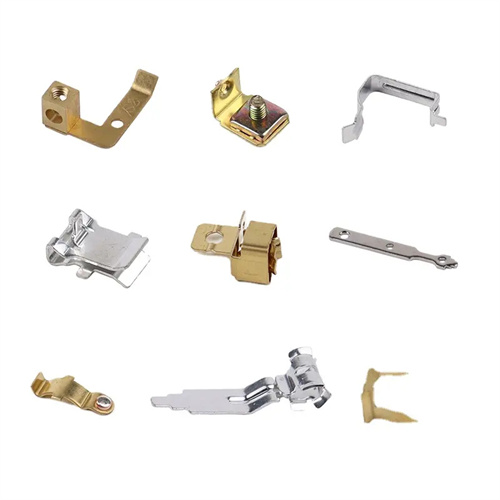
Electrical Contacts
Electrical Contacts are critical components used to establish and maintain electrical connections in various devices and systems. They ensure reliable power transfer, signal transmission, and secure connections, making them essential for the efficient operation of electrical and electronic equipment. Electrical Contacts are widely used in industries where consistent performance, durability, and precision are required.
Electrical contacts plate is mainly made of spring steel, stainless steel and copper parts. it is an important part of the switch. With the help of the conductivity of the electrical contact, it plays a high-quality switch between the operator and the product. The electrical contacts spring is mainly used in the film switching of hard board such as printed circuit board.
Features of Electrical Contacts
Electrical Contacts are characterized by their high conductivity, durability, and precision. They are designed to maintain consistent electrical contact, even under repeated use or mechanical stress. The contacts are often made from materials with excellent electrical and thermal properties, ensuring efficient power transfer and heat dissipation. They are also customizable in terms of size, shape, and material to meet specific application requirements.
Materials Used in Electrical Contacts
Electrical Contacts are typically made from materials with high electrical conductivity and corrosion resistance. Common materials include copper, brass, phosphor bronze, beryllium copper, and stainless steel. These materials are chosen for their ability to provide reliable electrical connections, withstand environmental factors, and maintain mechanical strength over time. Plating materials such as gold, silver, or nickel are often applied to enhance conductivity and corrosion resistance.
Production Process of Electrical Contacts
The production of Electrical Contacts involves several steps. First, engineers design the contact based on the specific requirements of the application. The appropriate material is then selected, and the metal sheet or wire is cut into the desired shape using stamping, laser cutting, or wire forming. The contact is then formed, bent, or stamped to create the necessary contact points and mounting features. Additional processes like plating (e.g., gold, silver, or nickel plating) may be applied to enhance conductivity and corrosion resistance. Finally, the contacts are inspected for quality, including electrical conductivity, dimensional accuracy, and surface finish.
Applications of Electrical Contacts
Electronics In the electronics industry, Electrical Contacts are used in devices such as connectors, switches, and circuit boards. They provide secure and efficient electrical connections, ensuring uninterrupted power supply and optimal device performance. Examples include contacts for USB connectors, PCB terminals, and relay switches. Electrical Appliances In the electrical appliances industry, Electrical Contacts are used in devices like washing machines, refrigerators, and air conditioners. They ensure reliable power transfer, enhancing the functionality and lifespan of the appliances. Examples include contacts for control panels, switches, and motor connections. Toy
In the toy industry, Electrical Contacts are used in battery-powered toys, such as remote-controlled cars, drones, and interactive toys. They provide durable and secure electrical connections, ensuring consistent performance and safety for children’s toys. Examples include contacts for battery compartments and motor connections.
Home Appliances
In the home appliances industry, Electrical Contacts are used in devices like cordless phones, smart home devices, and portable fans. These contacts ensure reliable power connections, contributing to the efficient operation and longevity of home appliances. Examples include contacts for charging ports and power switches.
Toy
In the toy industry, Electrical Contacts are used in battery-powered toys, such as remote-controlled cars, drones, and interactive toys. They provide durable and secure electrical connections, ensuring consistent performance and safety for children’s toys. Examples include contacts for battery compartments and motor connections.
Home Appliances
In the home appliances industry, Electrical Contacts are used in devices like cordless phones, smart home devices, and portable fans. These contacts ensure reliable power connections, contributing to the efficient operation and longevity of home appliances. Examples include contacts for charging ports and power switches.
 Sports Goods
In the sports goods industry, Electrical Contacts are used in battery-powered equipment such as fitness trackers, GPS devices, and electric sports gear. They provide durable and secure electrical connections, ensuring consistent performance and reliability for sports enthusiasts. Examples include contacts for battery compartments and sensor connections.
Electrical Contacts are essential components in industries such as electronics, electrical appliances, toys, home appliances, and sports goods. Their ability to provide reliable electrical connections, durability, and customization makes them ideal for a wide range of applications. As a manufacturer, leveraging advanced materials and production techniques for Electrical Contacts can help you meet the diverse needs of your clients while maintaining high standards of quality and performance.
Sports Goods
In the sports goods industry, Electrical Contacts are used in battery-powered equipment such as fitness trackers, GPS devices, and electric sports gear. They provide durable and secure electrical connections, ensuring consistent performance and reliability for sports enthusiasts. Examples include contacts for battery compartments and sensor connections.
Electrical Contacts are essential components in industries such as electronics, electrical appliances, toys, home appliances, and sports goods. Their ability to provide reliable electrical connections, durability, and customization makes them ideal for a wide range of applications. As a manufacturer, leveraging advanced materials and production techniques for Electrical Contacts can help you meet the diverse needs of your clients while maintaining high standards of quality and performance.